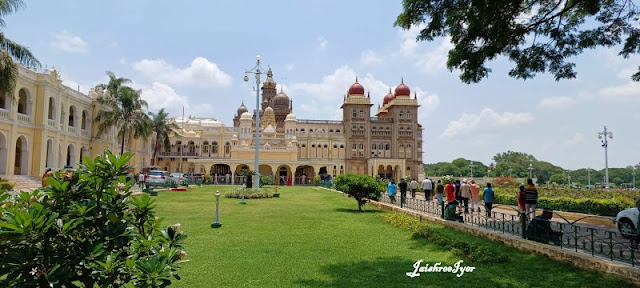Mysore Palace - It is known as
one of the riches and best palaces in India. It is not turned museum. We have
not seen in from inside but we haven't missed to see it enlightened with 54,000
bulb. It was a stunning scene and one should not miss it.
An ancient town on the foothills of Chamundi Hills, Mysore is also called Mysuru and is famously known as the City Of Palaces. The city owing to its rich history, splendid architecture, sandalwood goods and silk sarees, attracts thousands of visitors from all over the world. Besides being home to one of the largest palaces of India, the Mysore Palace, the renowned city of Mysore, also has several temples, churches, a lake and gardens for its patrons to explore and make the most of their time.
We visited the beautiful Mysore Palace, belonging to the Wodeyar Dynasty. We were astounded by its beauty as it shimmered, sparkled and shone in the light of the midday sun. We heard that the current scion of the Wodeyar Dynasty still lives behind the palace and participates in functions during the Dussehra Festival.
Synonymous with the term ‘grandeur’, Mysore Palace, also called Mysore Aramane, and Amba Vilas Palace, is one of India’s largest edifices. The palace was home to the Wadiyar Dynasty, which ruled Mysore from 1399 to 1950. The palace reflects the best Indo-Saracenic architecture and is also a UNESCO World Heritage Site. The exemplary architecture and rich history of Mysore Palace make it a top attraction not just in Karanataka but also in the whole country.
Mysore Palace: Architecture
Mysore Palace is built in an Indo-Saracenic architectural style and exhibits a culmination of Hindu, Mughal, Gothic and Rajput elements. Grey granite makes up the three-storeyed palace building and 145 feet five-storeyed towers while deep red marble adorns the domes of the Mysore Palace.
The domes for example is an element borrowed from the Islamic school of architecture. There are many deep pink marble domes projecting at the corners of the palace structure.
To easily understand the hybrid style, take a look at the tallest tower of the palace. This is a five storied tower measuring about 145 feet (45 meters) at the center of the palace.
The main palace is built amidst beautifully landscaped gardens. It has an intricately articulated elevation complete with bow-shaped canopies, curved arches and bay windows made in various styles, including Hindu and Byzantine.
The exteriors of the palace also feature two durbar halls. The palace’s interiors are equally quintessential and have several aspects enriching it, such as stained glass ceilings, carved doors, Czechoslovakian chandeliers, shiny tiled floors, sprawling pavilions and artwork from across the world.
Above the central arch of the palace facade is a beautifully designed structure of Goddess Gajalakshmi (Goddess of wealth and prosperity) with two elephants beside it. The architecture of this palace is truly majestic and should not be missed.
The palace is a three-storey stone structure made with fine granite, grey in colour, having deep pink marble stones atop and a five-storey tower measuring 145 ft. The size of the palace measures 245 ft. by 156 ft. Designs of the domes illustrate Indo-Saracenic architecture which was applied by the British architects in British India during the late 19th century.
It incorporates elements from Indian, Indo-Islamic, Neo-Classical and Gothic revival styles.
Three gates of the compound lead to the palace - the front gate (more specifically the East Gate) opens for the VVIPs and otherwise during the Dasara; the South Gate is designated for general public; and the West Gate normally remains open in Dasara. Apart from these the cellar of the palace has many secret tunnels that lead to several confidential areas and other places like the town of Srirangapatna.
Several fancy arches adorn the façade of the building with two smaller arches on either side of the central one that is supported with long pillars. A sculpture of the goddess of good luck, prosperity and wealth, Gajalakshmi, with her elephants is seated atop the central arch.
The palace facing Chamundi Hills is a manifestation of the devotion of the Maharajas of Mysore towards Goddess Chamundi. The emblem and coat of arms of the Mysore Kingdom adorns the entrance gate and arch. A large, beautiful and well-maintained garden surrounding the palace makes the site even more spectacular.
The exquisitely columned Durbar Hall, the solid silver doors, the finely incised mahogany ceilings and many other embellishments of the palace make one spellbound while giving an idea of the exuberant lifestyle of the royals. Displays in the palace include royal dresses, souvenirs, musical instruments and weapons used by the Wodeyars.
An array of superb paintings including the ones illustrating 8 manifestations of Goddess Shakthi as also a masterpiece by famed artist Raja Ravi Verma finds place in the palace.
InThe Mysore Palace you can enjoy feeling like royalty and you wander through the ornately decorated halls and corridors.The palace is definitely one of the best places to visit in Mysore and should be top of your Mysore attractions list!





















No comments:
Post a Comment